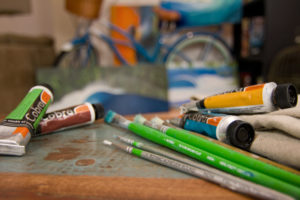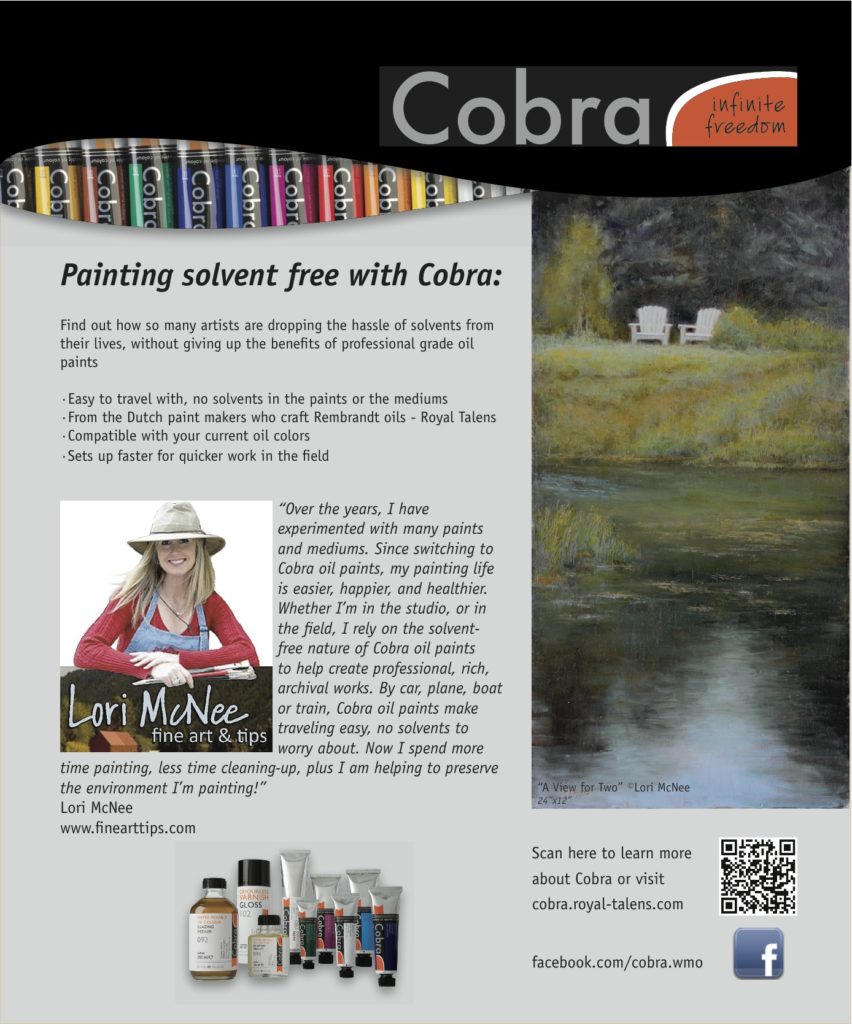 In the recent post, How to Become An Eco Friendly Artist, artist Scott Denholm shared his interesting environmentally friendly studio tips.
In the recent post, How to Become An Eco Friendly Artist, artist Scott Denholm shared his interesting environmentally friendly studio tips.
Please enjoy Part 2 where Scott gets specific. Below he shares his suppliers, and more great ideas, and examples to help you create your own eco friendly studio.
*****
Transforming your art and studio to become environmentally friendly isn’t an easy task, and many artists struggle. I’m also one artist who’s gone through the process. In order to help anyone wanting to make the same ‘tree change’ that I have, I’ll give a quick run down of some of the materials I use. Hopefully this will give you ideas of how to solve some issues.
Paints: For paint I use Royal Talens – Cobra Water Mixable, solvent free Oils and from time to time Golden OPEN Acrylics. This allows me to wash my brushes in water and soap, keeping my studio toxins to a bare minimum. To accompany them I use Landridge Low-toxic mediums and W&N water based varnishes.
Painting Supports: My choice of canvas is hemp. More and more people are realizing the environmental benefits of hemp over cotton. It is a superior and sustainable fibre than cotton requiring little to no fungicides, pesticides, water and fertilizer and producing up to 800% more per acre. I’ve never really liked the feel of cotton so hemp is a great alternative. And lets face it, if it was good enough for the masters, it’s good enough for me.
Paintbrushes: Most of my brushes are made by Australian company Micador, they have a line of high quality eco art brushes with handles made from FSC certified timber. For larger applications I use house painting brushes made from bamboo, recycled polyester and ferrule is made from recycled aluminium. The rest are old favourites that I’ve had for 15 years plus. There’s definitely no need to throw them out and create unnecessary waste. My favourite palette knife has also been with me for about 15 years.
Easels: I have a few easels, some are old but my favourite is made out of bamboo. It’s such a sturdy, versatile and sustainable wood.
Primer: My primer of choice is Tri-Art eco sludge, it’s a by-product of their acrylic paint manufacturing. This is one of my favourite eco art finds and is the best gesso I’ve used.
Tips for sourcing eco friendly art materials:
• Consider the full life-cycle of a product, not just what it’s made from.
• Where possible buy locally. It saves on shipping and reduces transport footprint.
• Reduce, reuse, recycle.
• Try to avoid toxic solvents. Not only does it benefit the environment but your health as well. Your lungs will thank you!
• Don’t worry if not everything you use is 100% environmentally friendly. Try your hardest because every little bit helps.
Think outside the box a little and you will find more ways to help the environment with your art other than just buying eco friendly materials. For example, if your paint does contain small amounts of hazardous materials, don’t just throw away the water/solvent you wash your brushes in down the drain. Most city councils/counties have responsible disposal services. I also use bamboo air cleaners to purify the air and plant trees in my local area.
Find non-profit organizations that are in your niche. For example, as a predominantly surf artist I support organizations like Sea Shepherd and Surfriders Foundation. Once you’ve got your favourites you can support them by donating to their causes and or donating paintings to help them raise funds at auction.
I hope I’ve given you enough inspiration and ideas to go out and transform your studio and art into eco friendly master pieces.
And if you already are creating eco art, I’d love to hear your stories and great materials you can’t live without! Please leave a comment below.
*****
*Guest author/artist: Scott Denholm is one of the worlds only eco artists, specializing in traditional landscape and seascape oil paintings using traditional Earth friendly materials. Thanks Scott for sharing these great environmentally friendly tips – I am going to try painting on hemp! I love using Cobra paints and highly suggest them to anyone who is working with traditional oils. In fact, here is a sneak peek at my upcoming ad for Cobra solvent free paints in Plein Air Magazine! ~Lori

PS. Let’s meet on Twitter, and on Google Plus, Pinterest, and join in the fun at Fine Art Tips Facebook Fan Page! Please checkout my art too LoriMcNee.com, or find me on Instagram lorimcneeartist. ~Lori 🙂
You might like to read:
The Healthy Artist: Simple Steps to Stay That Way
Water Soluble Oil Paints: Facts, Tips & Why I Use Them
Choosing Quality Art Materials and Supplies
Honoring Earth Day in My Own Private Idaho
How I Turned a TV Stand into an Artist’s Taboret
Build Your Own Art Gallery Hanging System for Around $100
Save Studio Space! Build Your Own Small Painting Racks








For printmaking, I love Daniel Smith’s water-soluble relief inks. Just as good as normal oil-based but doesn’t dry out as fast as water-based, plus completely safe to clean off with soap and water!
Nice one Maria, thanks for the tip! I have a friend who will love this 🙂
Scotty
Thanks for the added tip, Maria. I am happy to see you hear again.
Lori 🙂
I’ve never thought about painting on hemp. I’m going to look into that. I’ve also not yet tried any of the products made by Royal Talens. I’ve been using Winsor Newton and Grumbacher. I’ll have to give Cobra a try.
Thanks for the great article!
Glad you enjoyed this article Robert.
Best,
Lori
I, too, am a professional artist deeply committed to healthy and safe art studio practices. I’m constantly updating my research and finding new ways to implement more and healthier ways. Loved this article and will definitely check out hemp to paint on.
I just added a new small video for Solvent Free Oil painters who are interested in making their own Oil Jar (uber easy and cheap) for cleaning their brushes while painting. I’ve also just switched to rags rather than paper towels…always learning!
http://artforthesoulofit.com/2013/07/making-an-oil-jar-for-solvent-free-oil-painting/
Thanks Lori for your site of fab tips!
Joanie